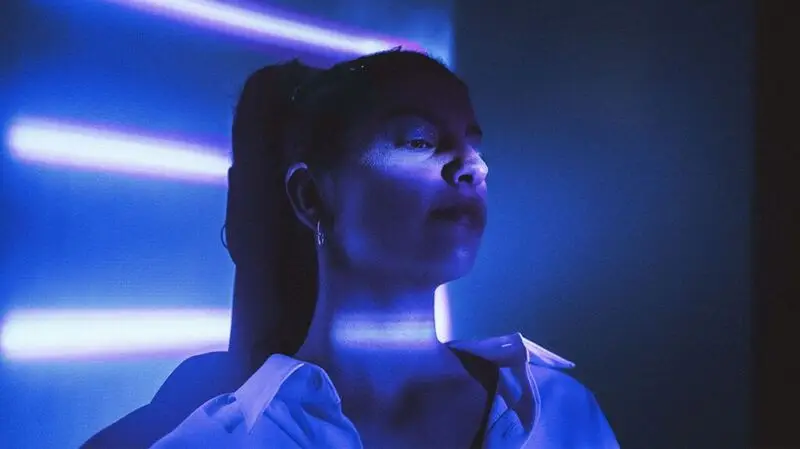
- Blue light from the sun is vital in regulating a person’s sleep-wake cycle.
- New research suggests the overall brightness of light plays a larger role in affecting a person’s “internal clock” than its color.
- The findings further our understanding on the effects of light on sleep quality and duration.
- Previous studies have shown that blue light from devices can damage the eyes and negatively impact sleep.
Of the seven colors in the visible light spectrum,
The majority of light coming from the sun is blue light, making it vital in helping to regulate a person’s sleep-wake cycle.
However, blue light is also the type of light emitted by computer screens, smartphones, tablets, and LED televisions.
Previous research shows that too much exposure to blue light from technology devices can potentially
Now, a new study by researchers at the University of Basel in Switzerland suggests the overall brightness of light plays a larger role in affecting a person’s “
The study was recently published in the journal
First study author Dr. Christine Blume, a psychologist at the Centre for Chronobiology of the University of Basel in Switzerland, said the main effect of light on the human internal clock and sleep is mediated via specialized light-sensitive
Ganglion cells are a type of photoreceptor that helps detect light intensity, allowing them to play a role in the sleep-wake cycle.
The other two photoreceptors in the eye — rods and cones — convert light coming into the eye into electrical signals relayed to the brain, providing vision.
“If light consists solely of short wavelengths of 440 to 490 nanometres, we perceive it as blue,” Dr. Blume explained to Medical News Today.
“If mixed with other wavelengths, the perceived color may change, even though the short-wavelength content remains constant. This was well-established even before our study. However, there was reason to believe that the color of light, which is encoded by the cones, could also be relevant for the internal clock because cone-signals (also) serve as an additional input to the internal clock. The question was whether this input is also relevant.”
— Dr. Christine Blume, first study author
For this study, Dr. Blume and her team recruited 16 human participants who were exposed to a blueish light, a yellowish light, and a white control light for one hour before bedtime.
Researchers designed the lights in a way that they activated the color-sensitive cones in the retina in a controlled manner and the stimulation of the light-sensitive ganglion cells was the same in all three conditions. This allowed scientists a way to separate the light properties that might affect the sleep-wake cycle.
Dr. Blume said they decided to focus on blue and yellow light in this study as a
“The most striking changes in brightness and light color (i.e., changes from orange to blueish or vice versa) occur around sunrise and sunset, marking the beginning and end of a day,” Dr. Blume noted.
“Thus, especially changes along the blue-yellow dimension may be relevant for the internal biological clock.”
At the conclusion of the study, researchers reported they found no evidence that the variation in light color along the blue-yellow dimension played a relevant role in affecting human circadian rhythm.
“Rather, our results support the findings of many other studies that the light-sensitive ganglion cells are most important for the human internal clock,” Dr. Blume said.
The researchers still recommend people reduce their exposure to short-wavelength light emitted from smartphones and other technology devices — despite what color it may be — before going to sleep, as they can affect circadian rhythm.
“The problem is that in everyday language we often refer to the short-wavelength light to which the specialized ganglion cells are most sensitive as ‘blue light’,” Dr. Blume explained. “This is despite the fact that the light does not have to be perceived as blue.”
“Our results support the findings of many other studies that the light-sensitive ganglion cells are most important for the human internal clock,” she continued.
“Therefore, short-wavelength light — misleadingly often termed ‘blue light’ — should be reduced in the evening, for example by dimming computer screens and using a night-shift mode. Avoiding screen time before bed can also help, as the things we do on our phones often delay sleep.”
After reviewing this study, Dr. Benjamin Bert, an ophthalmologist at MemorialCare Orange Coast Medical Center in Fountain Valley, CA, told MNT that this study was interesting as it tried to show that while light color may not make a difference to a person’s sleep-wake cycle, other aspects that could.
“They talked about
“But I think what we’re really seeing is that it’s so multifactorial that trying to figure out one specific thing that could be contributing to these issues or these concerns needs a lot of research to flush it out.”
MNT also spoke with Dr. Alexander Solomon, a surgical neuro-ophthalmologist and strabismus surgeon at Pacific Neuroscience Institute at Providence Saint John’s Health Center in Santa Monica, CA, who said the modulation of a person’s internal circadian rhythm is rather complex.
“There is a master ‘clock’ set by
Dr. Solomon said if a person is having difficulty sleeping and waking at a regular time needed for their lifestyle, one change could be to use blue light-blocking glasses or a similar phone or screen setting, but also to decrease overall exposure to bright light.
“Quite frankly, as shown by this study, a bright enough yellow light or medium brightness normal lighting is equivalent to a dim blue light after a certain time,” Dr. Solomon explained.
“There can be many other factors that play a role in difficulty sleeping, and seeing a sleep specialist/hygienist may be helpful before attributing it to a single factor such as light exposure,” he added.
Dr. Bert agreed: “Usually when we’re looking at something, we’re also activating the brain, which makes it harder for us to kind of calm down and be able to easily go to sleep.”
“It would still be a good practice to take a break from anything that is projecting light into your eyes a few hours before trying to go to sleep and just give yourself some time to relax and let your brain calm down as well to ease you into sleep.”
— Dr. Benjamin Bert, ophthalmologist





